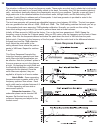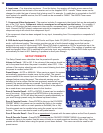
2. Setup Speaker Location
Ideally the speakers should be positioned at an equal distance from the
listening position. However, physical limitations usually require placing
the speaker in other than optimum locations. The surround processor
contains a means to electronically move each speaker’s location. This
allows for superior reproduction of the directional cues available during
movie or music playback. Measure the distance in feet from your
listening position to each speaker. Enter this information into the menu.
The units can be changed to meters if preferred.
3. Setup Speaker Levels
Speaker level calibration will generate pink noise to allow the equaliza-
tion of the volume levels of each speaker to make up for differences in
speaker characteristics and distances from the listener to the speakers.
Best results will be achieved using a Sound Pressure Level (SPL)
meter. Set it to C Weighting and Slow Response. Place the meter at
your listening position and adjust each speaker for an equal response.
(SPL of 75dB recommended).
If you don't have an SPL meter, adjust the levels by ear. Step through
each speaker and adjust for approximately equal volume levels.
4. Setup Crossover + LFE
High / Low pass crossover frequency - This sets the frequency at
which bass tones are filtered from the small speaker channels and sent
to the subwoofer. Set this according to the capabilities of the speakers.
For very small bookshelf speakers the frequency may need to be raised
to 100 or even 150 Hz. For speakers with larger woofers, the crossover
frequency can then be lowered so only the lowest tones are sent to the
subwoofer.
High / Low pass slope - A crossover doesn't simply send all content
above 81 Hz to the main speakers and all content below 79 Hz to the
sub. Instead there is a gradual transition. The crossover point is the frequency at which the amount of infor-
mation in the subwoofer and main speaker(s) is equal. The crossover slope determines how gradual or
abrupt this transition occurs (6, 12 or 24dB). More gradual slopes generally result in a smoother transition
from main speakers to subwoofer. However, gradual transitions can cause distortion in small main speakers
because too much bass is sent to them. Gradual transitions with higher crossover settings can also cause the
perceived location of a sound to move from the correct main speaker location. Normally, you will want to use
identical slopes for high pass and low pass. However, many small speakers include a 12dB high pass slope
in the speaker itself. If this is the case, you will want to choose a 24dB low pass slope and 12dB high pass
slope so that the end result is 24dB in both the subwoofer and main speakers. The crossover frequency
should be set to match that built into the speakers (typically 80Hz).
The low pass slope can be set to EXTERNAL, 6, 12, or 24dB. The EXTERNAL setting will send full range to
the subwoofer output allowing an external crossover to handle the low pass slope. If the subwoofer has an
off or bypass selection for it's internal crossover, we recommend setting it to off and using the receiver's
crossover. If the subwoofer's crossover cannot be bypassed, but can be set to a high frequency, then the
receiver’s crossover can be used. If the subwoofer’s crossover can't be defeated or raised to a high
frequency we recommend that you set the receivers's low pass slope to external and adjust the receiver's
crossover frequency to match that of the subwoofer.
26
SPEAKER LLOCATION ffeet
Left CCenter RRight
Front 10.0 110.0 10.0
Surround 110.0 10.0
Back 10.0 10.0
Subwoofer 110.0
↑↓ next iitem aadjust ←→
MENU ssetup sspeakers
SETUP SSPEAKER LLEVELS ddB
Left CCenter RRight
Front 0.0 00.0 0.0
Surround 00.0 0.0
Back 0.0 0.0
Subwoofer 00.0
↑↓ next iitem aadjust ←→
MENU ssetup sspeakers
SETUP CCROSSOVER ++ LLFE
1 CCrossover FFreq 80.0 HHz
2 HHigh PPass SSlope 12.0 ddB
3 LLow PPass SSlope 24.0 ddB
4 LLFE LLevel 00.0 ddB
↑↓ next iitem aadjust ←→
MENU ssetup sspeakers


















